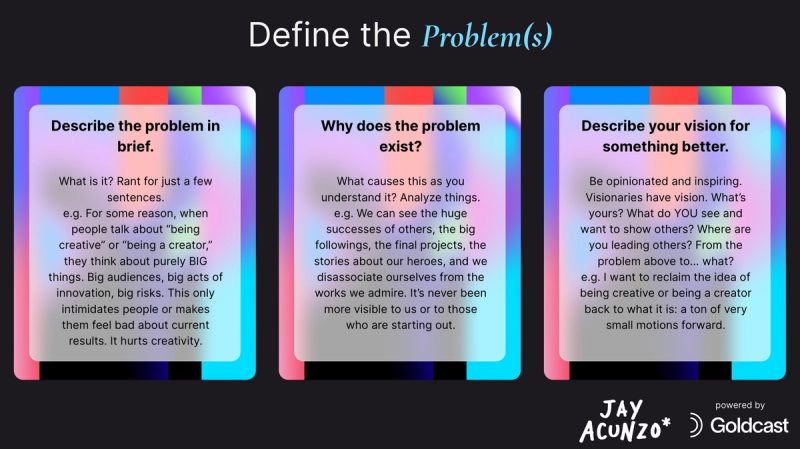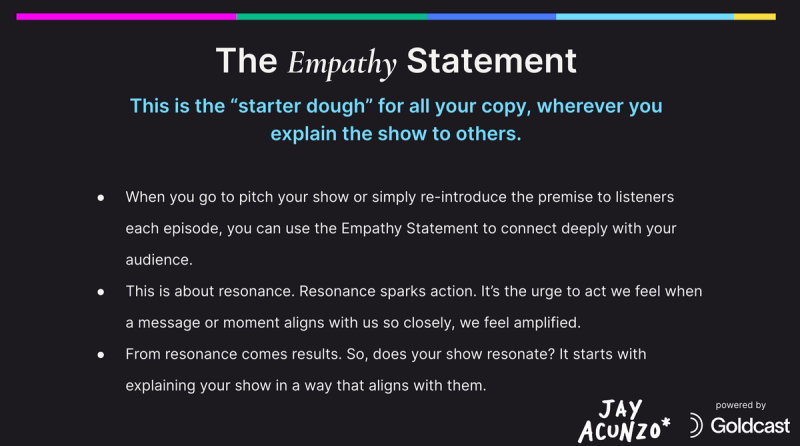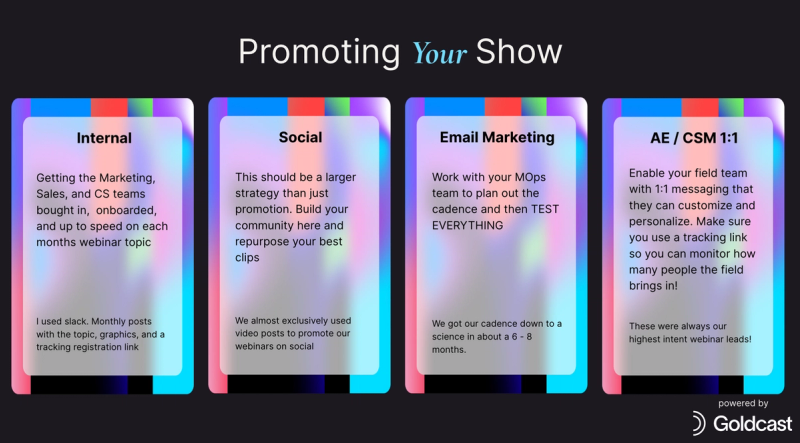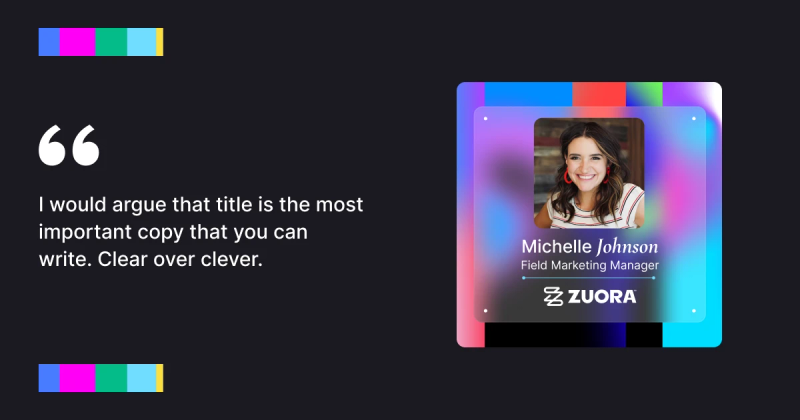Every Successful Series Starts With a Premise

Table of Contents
Maximize Your Marketing ROI
Join 10,000 other marketers already getting the best tips on running engaging events that boost pipeline and create raving fans.
In the first two installments of our Series Masterclass, we talked about why you need a series and how to get other departments involved.
Now, it's time to map out the route to get you from "series hopeful" to "successful series creator." How do you pick your idea for your first series? What sort of foundation does your series need? And where do you go from there?
To answer those questions, Goldcast's Lindsay McGuire spoke with Jay Acunzo, host of the Unthinkable podcast and co-founder of Creator Kitchen, as well as Michelle Johnson, Field Marketing Manager at Zuora.
Both Jay and Michelle are thought leaders when it comes to serialized content. Jay used to work in content marketing for companies like HubSpot and Google, and he now partners with companies to create successful shows. His podcast has over 1M downloads! Meanwhile, Michelle ran a show at BombBomb for three years.
Read on to learn:
- Why launch a series?
- Series = Consistency + Change
- What is a premise?
- How to develop a premise
- Who is your premise for?
- Meet people with empathy
- How to plan for and promote your series
- Watch the full episode for more series tips
PS: Watch the full episode below if you want to follow along!

Why launch a series?
Michelle worked with Steve Pacinelli at BombBomb, and one of his quotes that stayed with her was, "Be of value and abundance will follow."
One of the most important and recurring ways you can provide value to your audience is through a series! As we know, most of your audience is not in the active-buying stage of the cycle, so you can reach them and engage with them through content like a series.
Another memorable Steve Pacinelli quote is, "Every webinar that your customer or prospects attends trains them to attend or ignore the next one." That means the value has to be recurring here; you can't just phone it in!
We need to be in touch with our audiences and what they're thinking, feeling, saying, and doing so we can give them the value they're looking for.
Series = Consistency + Change
Jay points out that consistency and change are two elements that are inherent to a series.
A series is consistent because you're showing up regularly over time, and you'll be able to own the idea in the public marketplace.
It involves change because if you're in it for the entire journey, something about your current approach or way of thinking will give way to something better or more effective—this part helps you become a leader!
"We're launching this series because something's gonna be different by the time we're done." - Jay Acunzo, host of the Unthinkable podcast and co-founder of Creator Kitchen
What is a premise?
The problem with a lot of series is that companies are all competing on the same topics and trying to "out-expert" everyone else. Generalized expertise is commodified; people can get it almost anywhere. When you sell a commodity, the only way you can compete is on volume or speed, which can sometimes be tricky to maintain.
However, when you develop a great premise, your audience has every reason to care. A premise combines your topics and your hook, and it delivers emotional resonance. It pushes people to subscribe and share.
"The premise is supposed to be the first step of any strategic development of anything serialized." - Jay Acunzo, host of the Unthinkable podcast and co-founder of Creator Kitchen
So, what is a premise? Jay defines a premise as "the specific, defensible purpose pulled from your personal vision for your audience." The premise harnesses the power of trying to own an idea and be associated with it.
Let's look at an example. Say you're looking at a music podcast featuring interviews with artists, producers, and journalists talking about the latest trends in the music industry. Sounds pretty interesting, right?
Then, you find out about Cole Cuchna's Spotify show, Dissect.
The premise of the show (taken straight from the site): "It's a serialized music show that examines a single album per season, one song per episode. Because great art deserves more than a swipe."
Wayyyy more interesting than the first podcast, is it not? In a world where we scroll endlessly through content, Dissect was created to counter this cultural shift. This premise is true to the right people, and it may be something that the wrong audience would battle against if they disagreed.
The distinct perspective is obvious, and it's compelling.
How to develop a premise
A premise always starts with a frustration. What are you really frustrated by or annoyed about? What is your perspective? Be honest! Don't worry about finding the right language to articulate your thoughts publicly yet. That'll come later.

So, start by describing the problem. What do you solve? Can you rant for a few sentences? Can you just get some copy down to start with? Jay provided an example in which we're making a show about successful professional creators. There are a ton of these shows, but the problem we identify is that people talk about the big, BIG wins so much that a lot of people might be intimidated to even start.
From there, why does this problem exist? Here, act more like an investigator than an expert. In our example, maybe we can see that we have all these heroes out there to admire, and it makes the everyday person think they could never achieve that. But why is that? Maybe we think it's because you can now see how widely followed your heroes are. What you're seeing is causing you to think you shouldn't try.
Describe your vision for something better. In our fictional example, the vision is reclaiming the idea of creativity, not as doing something BIG but as all the tiny choices you make to create something that others might deem big.
Three traits of a good premise
If you want to know if you've got a strong premise, run it against these three qualities and make sure it passes the test:
- Is it an idea you can own? Ideally, you're not necessarily the expert, but you have a lot of questions and you want to explore them along with others in an ongoing way.
- Can you quickly and easily articulate your premise? Is it free of jargon and invented terms?
- Can you evolve the premise? Could it grow into a whole platform of ideas? Even if you only ever leave it as a series, you could theoretically also do a podcast, upsell, or develop it in some other way.
If you're checking off all three boxes, you've likely got a good premise on your hands.
Who is your premise for?
Now that we know our premise, we need to describe our intended audience. At Zuora, Michelle and her team try to sit in the shoes of their audience. Invite different departments to brainstorm: What are these people in your audience thinking? What are they talking about? What are they feeling?

You would think these answers would be repetitive, but you might find that your CSMs and AEs and other staff have very different input for these roles and what matters to them, contributing to a more well-rounded picture of your audience members.
Meet people with empathy
It's not enough to just identify what people are frustrated about; we have to position it in a way that meets people where they're at and walks them through every step of the way, so they end up where we want them to be.
Jay modified something from Hollywood to apply to our role as marketers and brand builders, and it's called "the empathy statement." According to Jay, this is the starter dough to bake your bread from.
"If you read a good empathy statement, it sounds like a series trailer or a landing page." - Jay Acunzo, host of the Unthinkable podcast and co-founder of Creator Kitchen
This is where knowing your audience the way we just talked about will come in handy. Your empathy statement will answer the question your audience is thinking: Why is this content for me? Again, you want resonance here, to spark people to move based on your message.
Address your audience directly in two ways:
- "You are…" For example: You're an aspiring entrepreneur.
- "You want…" You want to take the leap, but it seems like only BIG moves will get you there, and you feel intimidated.
By touching on how people self-identify and what their goals are, you're immediately aligned with them. You resonate!
Make sure you're addressing the frustration in plain language. Then, agitate the frustration—ask questions like, "Are you doomed to this fate?" This gets people worked up and emotionally invested to see what happens next.
After you've built some tension, it's time to pitch them: Join us on this podcast journey as we talk to professional creators that you already know of; they'll dissect one favorite project piece-by-piece and show us all the tiny motions they went through to get there—motions which, by the way, you can do too.
How to plan for and promote your series
Before we close, let's talk about a few quick promotional tips for your series!

When running a series, Michelle always hosted a monthly planning call with her internal cross-departmental stakeholders. That meant somebody from CS, people from marketing, MOPs, sales, and other areas all attended. The team only planned one month in advance because things moved fast within the company's startup culture, and they used the time to reflect and name the next topic.
Once you've nailed down the topic, move on to copywriting. Write your description first and then your title, and aim for clear copy over cleverness. There's so much noise and AI-generated copy out there, so be clear and direct. A/B test your copy as much as you're able. Michelle would write 20 different titles every time and have her team vote on them!
"I would argue that title is the most important copy that you can write. Clear over clever." - Michelle Johnson, Field Marketing Manager at Zuora

When you have your title and description down, your landing page and emails will basically write themselves. More is not always more when it comes to email marketing, so test what frequency works best for your audience. Michelle found that a two-email sequence worked well for her, with the second email going out a day before the event and driving a staggering 60% of registrants!
Finally, if you can give your AEs and CSMs solid messaging for 1:1 outreach, that can help with inviting prospects to the series. Michelle found that sometimes the most valuable attendees actually came from these efforts.
Watch the full episode for more series tips
Honestly, there were so many goodies in this episode that we couldn't share all of them in this blog post! We highly encourage you to watch the episode in its entirety and take notes on everything Lindsay, Jay, and Michelle covered!

Transform Your Video Marketing with AI
Stay In Touch
Platform
Resources
© 2025 Copyright Goldcast, Inc. All rights reserved.





 Upcoming Events
Upcoming Events Event Series
Event Series On-Demand Events
On-Demand Events

